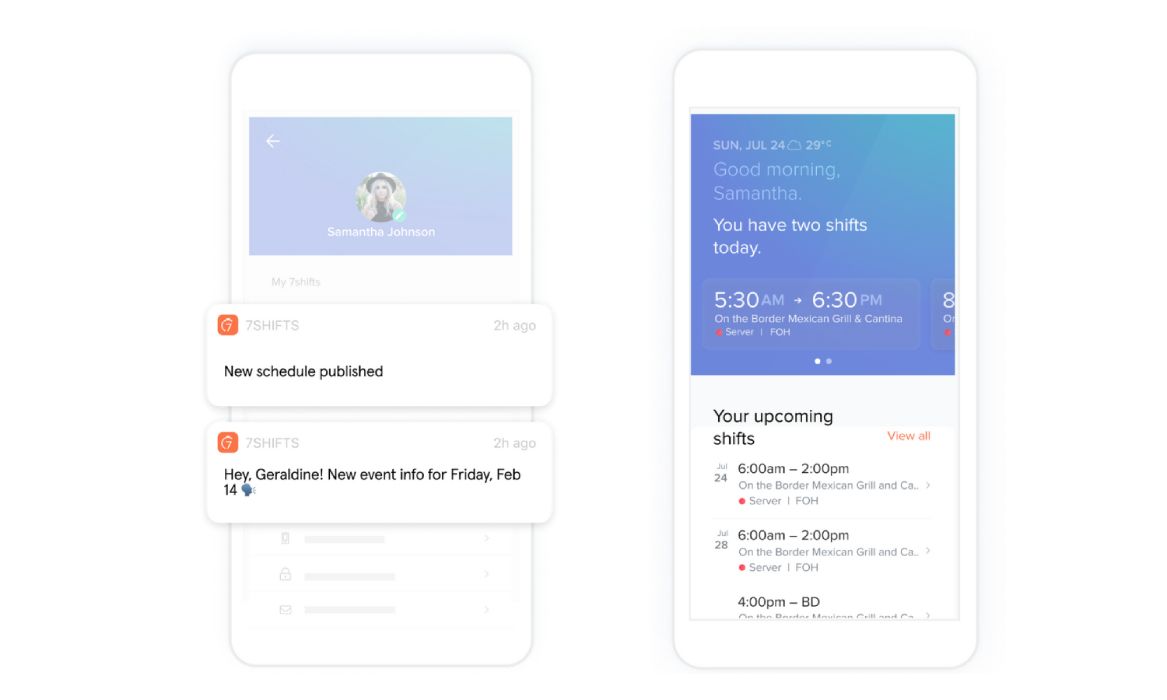How does an extra day off every other week sound?
Not only is it possible — it’s popular. It’s called the 9/80 work schedule, and it rewards employees with an additional, full day off from work in exchange for working slightly longer shifts without affecting full-time status.
So, what exactly is the 9/80 schedule, what are its benefits, and how can it work in your restaurant?
What is a 9/80 Work Schedule?
The 9/80 work schedule refers to a method that differs from the traditional eight hours a day, five days a week work schedule. In a two-week period, employees will instead work one eight-hour day, eight nine-hour days, and receive one extra day off.
Essentially, the eight hours from the additional day off are distributed among eight of the nine remaining workdays in a two-week working period. With this scheduling style, employees work 80 hours in nine work days rather than ten — hence the “9/80” title.
The 9/80 differs from what is viewed as the “normal” 5/40 work schedule, where employees work 40 hours over the course of five workdays. This approach is similar to the 4/10 work schedule, where employees work ten-hour shifts over four days, thereby evenly distributing the extra eight hours a week into the remaining four days. However, because 9/80 takes place over two weeks instead of one, the traditional eight-hour shift only increases by one hour for most days.
Recommended Reading: How to Create a 24 Hour Schedule for Your Restaurant (5 Examples)
Sample 9/80 Schedules
Below is a visualization of what a traditional 9/80 schedule looks like.

In the above example, notice how — during both weeks — employees are on the schedule to work nine-hour shifts during four of the week’s days. On one day (the first Friday), employees only work eight hours, while on the second Friday, they get a bonus day off for a three-day weekend.
Offering more flexibility during the week
Because restaurants have unique staffing needs, this schedule would need to be adjusted for each employee. For example, the schedule above has Saturday and Sunday marked as days off, which isn’t the norm in a restaurant. Instead, maybe all employees’ schedules require nine-hour shifts on Friday and Saturday and offer more flexibility throughout the week. Here’s an example of what that might look like.
|
Sun |
Mon |
Tues |
Weds |
Thurs |
Fri |
Sat |
|
Day Off |
Day Off |
Eight-Hour |
Nine-Hour |
Nine-Hour |
Nine-Hour |
Nine-Hour |
|
Day Off |
Day Off |
Extra Day Off |
Nine-Hour |
Nine-Hour |
Nine-Hour |
Nine-Hour |
The 3-day weekend
Finally, while one of the major benefits of a traditional 9/80 work schedule is a three-day weekend, it isn’t always feasible to give every employee three consecutive days off in a restaurant. Here’s what a 9/80 schedule might look like that doesn’t incorporate this perk, but still offers the extra day off.
|
Sun |
Mon |
Tues |
Weds |
Thurs |
Fri |
Sat |
|
Eight-Hour |
Day Off |
Nine-Hour |
Nine-Hour |
Day Off |
Nine-Hour |
Nine-Hour |
|
Extra Day Off |
Day Off |
Nine-Hour |
Nine-Hour |
Day Off |
Nine-Hour |
Nine-Hour |
Because your restaurant’s hours, days of operations, and staffing needs will vary, it could result in a few different 9/80 schedules for your employees. Keep that in mind as you consider this option.
Important Notice
The information contained in this article is general in nature and businesses should consider whether the information is appropriate to their needs. Legal and other matters referred to in this article are based on 7shifts’ interpretation of laws existing at the time and should not be relied on in place of professional legal advice.
Please check with your local and state laws to make sure you’re in compliance with any regulations regarding pay, hours worked, overtime and other payroll considerations when implementing any type of schedule.
Benefits of a 9/80 Schedule
The 9/80 work schedule is growing in popularity thanks to the benefits it presents to employees and their managers. Here are just a few of the ones you might see in your restaurant if you decide to implement 9/80.
Another Day Off
Let’s start off with the obvious one – with a 9/80 work schedule, employees get an extra day off every other week they work.
around the world. Employees have the opportunity to achieve a healthier work-life balance under this format, using the extra days to travel, spend time with loved ones, run errands, or just check out that movie they’ve been dying to see. Since employees come to shifts with more energy and less exhaustion, this extra day off can increase employee productivity by 20% and decrease work-related stress by 27%.
An Incremental Increase in Working Hours
To address the elephant in the room, yes — the 9/80 scheduling method does increase the duration of employees’ workdays by one hour, or 12.5%. However, other scheduling methods like the 4/10 try to condense 40 hours into four days of work, meaning daily shift lengths increase by two hours (25%). The 9/80 method is considered to be a more palatable option, as its additions to the workday are minimal by comparison – especially when considering the reward of a full, uninterrupted day off.
More Tips
For front-of-house employees, a 9/80 work schedule might mean working an extra hour on busier days (Thursday-Saturday) in exchange for taking a slower day off. The switch could result in more tips for the same amount of hours worked, effectively boosting their hourly rate.
One Less Commute
One fewer day working means one fewer day commuting. Let’s say it takes 30 minutes each way for employees to get to work for an hour round-trip each workday. With a 9/80 work schedule, employees would earn back approximately 26 hours – or one day – each year that they would have otherwise spent in their cars or on public transportation. Seeing as excessive commuting has been directly proven to cause unhappiness, this bi-weekly break should be perceived as a benefit by your staff.
Disadvantages of a 9/80 Schedule
Naturally, any change in scheduling comes with its downsides. Here are a few reasons why a 9/80 schedule might not be the best fit for your restaurant.
Longer Workdays
Most of an employee’s workdays will increase by an hour under the 9/80 method. In order to work that extra hour, employees will have to show up early or work later. This means social lives, daycare pickup, and sleep schedules could all be impacted for eight days in exchange for just one day off in a two-week cycle.
Scheduling Fixed and Rotating Days Off
A 9/80 schedule is more common in businesses that can set every other Friday or Monday as their “off” day. It makes for a simple setup that all employees clearly understand and benefit from. In restaurants, however, it’s a bit more complicated to manage.
Your restaurant is likely open for more than nine hours every day and more than five days a week — with every hour of operation requiring coverage by several workers. Crafting a 9/80 schedule to provide everyone on your staff with three full days off every other week can be a challenge since there are so many moving parts to restaurant scheduling.
Recommended Reading: The 11 Employee Scheduling Best Practices + Tips for Restaurants
Managing Time-Off Requests
The fluctuations between eight-hour days, nine-hour days, and days completely off can cause complications when managing personal and vacation days. Specifically, if you grant an employee a time-off request, or if someone needs to take a sick day, you’re more than likely giving them nine hours off instead of eight. This change can make the process of accruing and using time off more complicated and can leave the restaurant more short-staffed in tight times.
Additionally, this problem can also arise during the holidays, as you’ll need to manage time-off requests alongside fixed and rotating days off for several employees.
How does a 9/80 schedule affect payroll?
Technically, the 9/80 requires employees to work more than 40 hours in a calendar week.
However, that does not mean you have to pay employees overtime.
The Department of Labor specifies that an employer may set an employee’s workweek to start on any day or any hour of the week, so long as it is a fixed, regularly-recurring, 168-hour time period. In other words, the start of an employee’s workweek does not have to coincide with the calendar.
For example, let’s say an employee on a 9/80 schedule works nine-hour days from 11-9 on Monday-Thursday and every other Friday from 11-8, with a one-hour unpaid break from 3:00-4:00 each day.
In this situation, this employee’s workweek would start and end on Fridays at 3:00. That employee would work four nine-hour shifts and half of an eight-hour shift each “week” for an exact total of 40 hours. This approach allows your restaurant to utilize a 9/80 schedule without paying overtime costs.
Implementing a 9/80 Work Schedule In Your Business: 7 Easy Steps
If you’ve determined that a 9/80 work schedule is the best decision for your business, here are the steps you should take to successfully get your staff on board, build a schedule, and start using it in your restaurant.
1. Get Your Team’s Buy-in
Moving to a 9/80 work schedule can be a big change for your staff. While restaurant employees are used to working late hours and having Tuesdays off instead of Saturdays, you’ll still want to run the idea of a 9/80 schedule by your staff before implementing it.
You can do this by explaining the benefits of 9/80 (outlined in the section below), hearing and responding to any concerns they have, and working with them to choose their fixed and rotating days off for each schedule rotation.
2. Confirm Team Availability
A grasp on team availability is even more essential in 9/80 scheduling, as overtime windows are more sensitive. Before making the schedule, make sure you’re in-tune with your employees’ ongoing availability for their normal workweeks as well as time-off requests.
You can use employee scheduling software that allows employees to submit their availability for shifts to see if it’s even feasible to build an 9/80 schedule—given their availability alongside the restaurant’s operating hours.

7shifts employee availability and time off requests on desktop and mobile
3. Develop the Schedule
Once you’ve confirmed availability, the next step is to develop a schedule that balances employee availability, overtime costs, factors in rotating days off, and meets guest demand.
Yes — that does all sounds like a lot! Thankfully, there are tools available to help you develop a compliant and accurate employee schedule. 7shifts has an auto-scheduler feature which factors in all of these elements to build an ideal schedule. If you’re using 7shifts restaurant scheduling software, you can refer to this article for how to build a schedule that meets the requirements of 9/80.

7shifts Scheduling Dashboard and Software
4. Send to the Team
Once everyone understands and approves of the change, the next step is to communicate the updated schedule to your team. You can use employee scheduling software to build, publish, and share these new schedules with staff immediately. That way, if any unspoken concerns come up, employees can address them with you before the new schedule goes into effect.

7shifts mobile app notifications and shift view for a schedule
5. Instruct on Shift-Swapping
Implementing a 9/80 doesn’t mean swapping shifts will be a practice of the past. That said, you may need to provide additional instructions for shift-swapping under a 9/80 schedule. For example, if an employee wants to trade their eight-hour shift for a co-worker’s nine-hour shift, that could cause complications with the implementation of 9/80.
There can also be a situation where a shift swap adds a full shift onto an employee’s schedule during one of their fixed or rotating days off. This situation would result in higher wages due to overtime and could inflate the restaurant’s labor budget if it happens too often. Having clear rules about who is eligible to accept swap requests diminishes the risk of these instances occurring.

7shifts shift trading features
6. Managing Holidays
Holidays — and any days when the restaurant is closed – will impact employees who otherwise would have had shifts scheduled. Employees might begrudgingly find themselves working on a day they were hoping to have off, particularly around the holidays.
In preparation for these circumstances, you should take the proper steps to build a holiday work schedule – especially when you have to factor in the rotating days off that a 9/80 schedule brings.

7shifts time off requests feature
7. See how it’s working
To determine if your 9/80 schedule is a success, you’ll need to see if employees are adhering to the schedule. If someone is missing shifts or clocking in late more often than usual, it could be an indicator that they’re struggling to adjust to the 9/80 format.
Using employee engagement software to quickly identify these employees and speak to them about how to improve their performance can result in a happier, more productive, and more punctual staff.
Frequently Asked Questions
How is Overtime Calculated on a 9/80 Schedule?
Because workweeks can be defined as any fixed, continuous 168-hour period, employees working a 9/80 schedule are not automatically eligible for overtime.
A 9/80 schedule has one eight-hour day in its two-week cycle, so an employee’s “workweek” can start and end in the middle of their eight-hour shift day so as to not exceed 40 hours of work in that set period. To curtail overtime costs on a 9/80 schedule, employees should only be allowed to trade shifts that do not cause them to exceed 40 working hours in that 168-hour window.
Is a 9/80 Schedule Worth It?
This type of work schedule is more common in white-collar jobs than in the service industry, but if it’s feasible in your restaurant, it does offer perks to both workers and their employers that traditional schedules do not.
The extra day off every two weeks offers a ream of psychological benefits that positively affect employees’ professional and personal lives.
However, since the restaurant industry operates with longer hours and larger staff sizes, it does pose logistical complications that make a 9/80 schedule more of a challenge to successfully maintain in a restaurant.

AJ Beltis, Author
AJ Beltis
Author
AJ Beltis is a freelance writer with almost a decade of experience in the restaurant industry. He currently works as a content manager at HubSpot, and previously as a blogger at Toast.
